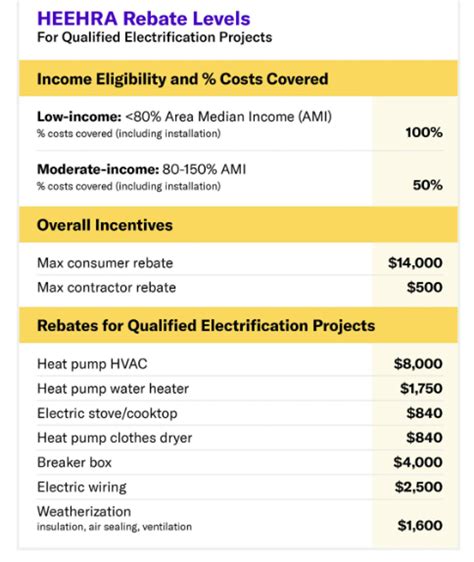Unlock Savings: How the Home Efficiency Rebate Program Can Reduce Your Energy Bills
In today’s world, where energy costs are unpredictable, homeowners are constantly seeking ways to reduce their utility bills. The Home Efficiency Rebate Program offers an excellent opportunity for homeowners to improve their homes while simultaneously decreasing energy consumption. This article delves into the specifics of this program and how it can lead to substantial savings on energy bills.
What is the Home Efficiency Rebate Program?
The Home Efficiency Rebate Program is a government initiative aimed at promoting energy efficiency in residential homes. The program offers financial incentives for homeowners who make energy-efficient upgrades. By providing rebates for various upgrades, this program not only helps reduce energy consumption but also enhances comfort levels within homes.
Key Benefits of the Program
The advantages of participating in the Home Efficiency Rebate Program are manifold. Here are some of its most significant benefits:
- Financial Savings: Homeowners can receive substantial rebates that offset the cost of making energy-efficient upgrades, such as installing new insulation, upgrading heating and cooling systems, or replacing windows.
- Lower Energy Bills: With efficient home upgrades, homeowners can expect reduced energy consumption, which translates to lower utility bills each month.
- Environmental Impact: By improving energy efficiency, homeowners contribute to a reduction in overall energy demand, which is essential for minimizing carbon footprints and promoting sustainability.
- Increased Home Value: Energy-efficient homes often have a higher resale value, potentially yielding a better return on investment when it comes time to sell your property.
- Comfort and Health: Improved insulation and updated HVAC systems can enhance indoor air quality and comfort, creating a healthier living environment for families.
Types of Upgrades Covered
The Home Efficiency Rebate Program encompasses a wide range of improvements. Here are some common upgrades that might qualify for rebates:
- Insulation: Upgrading your home’s insulation helps maintain temperature, reducing the workload on heating and cooling systems.
- Windows and Doors: Energy-efficient windows and doors significantly decrease heat loss, making homes more comfortable and reducing energy bills.
- Heating and Cooling Systems: Replacing outdated heating or cooling systems with energy-efficient models can lead to significant savings on energy costs.
- Water Heating: Upgrading to energy-efficient water heaters can also contribute to reducing overall energy consumption.
- Smart Thermostats: Installing smart thermostats can optimize heating and cooling schedules based on occupancy, leading to further energy savings.
How to Apply for the Program
Applying for the Home Efficiency Rebate Program is a straightforward process:
- Check Eligibility: Begin by checking if your home qualifies for the program based on the criteria set by your local utility or government agency.
- Get a Home Energy Audit: Many programs require homeowners to obtain a professional energy audit to identify opportunities for improvement.
- Choose Your Upgrades: Decide which energy-efficient upgrades you would like to pursue, keeping in mind the rebates available for each.
- Complete Upgrades: Hire licensed professionals to complete the necessary upgrades, ensuring all work complies with local building codes.
- Submit Your Application: Gather necessary documentation, including proof of purchase, and submit your rebate application through the designated channel.
- Receive Your Rebate: Once your application is approved, you’ll receive your rebate in the form of a check or direct deposit.
Cost vs. Savings Analysis
While upfront costs for energy-efficient upgrades can be significant, it’s essential to conduct a cost vs. savings analysis. By evaluating the potential savings on energy bills alongside the cost of upgrades, homeowners can make informed decisions. Many upgrades pay for themselves within a few years due to reduced utility bills, reinforcing that investing in energy efficiency is financially wise.
Case Study: Real-Life Savings
To illustrate, let’s consider a hypothetical homeowner, Jane. After obtaining an energy audit, she decided to replace her old heating system and upgrade her insulation. The total cost was approximately $5,000. However, she qualified for a rebate of $1,500 from the Home Efficiency Rebate Program, reducing her out-of-pocket expense to $3,500.
Over the next year, Jane noticed her energy bills dropped by 30%. This resulted in an annual savings of around $600. Within six years, her investments would pay off in energy savings alone, not to mention the added comfort and potential increase in her home’s market value.
Conclusion
Participating in the Home Efficiency Rebate Program can unlock significant savings for homeowners. By making energy-efficient upgrades, you not only reduce your energy bills but also contribute positively to the environment while enhancing the overall comfort of your home. With a range of rebates available and a straightforward application process, there’s no better time than now to consider the upgrades you could make to unlock savings.
FAQs
1. Who is eligible for the Home Efficiency Rebate Program?
Eligibility varies by region but typically includes homeowners and sometimes renters with permission from the property owner. Check your local program guidelines for specifics.
2. What types of upgrades are most common for rebates?
Common upgrades include insulation, windows, HVAC systems, water heaters, and smart thermostats, among others.
3. How long does it take to receive the rebate after applying?
Rebate processing times can vary, but homeowners typically receive their rebates within a few weeks to several months after submission, depending on the program guidelines.
4. Is there an application fee for the rebate program?
Most programs do not have an application fee, but it’s wise to confirm with your local program to avoid any surprises.
5. Can I apply for multiple rebates at once?
Yes, many programs allow homeowners to apply for multiple rebates, provided they meet the criteria for each upgrade.
Download Home Efficiency Rebate Program
